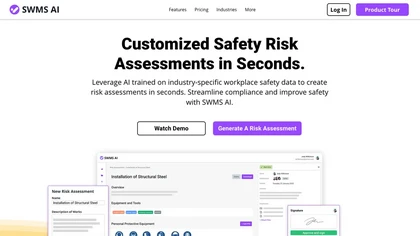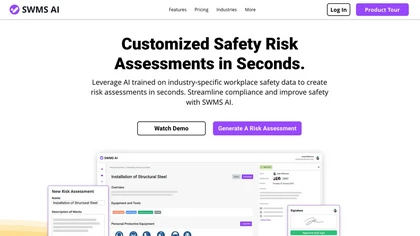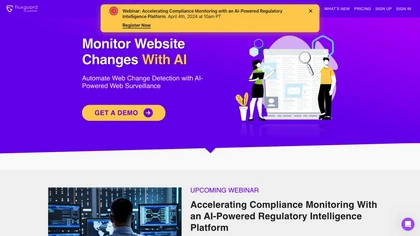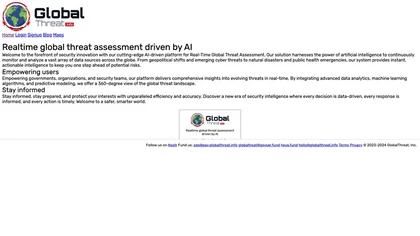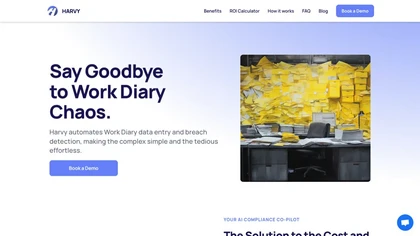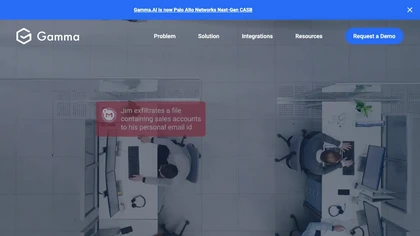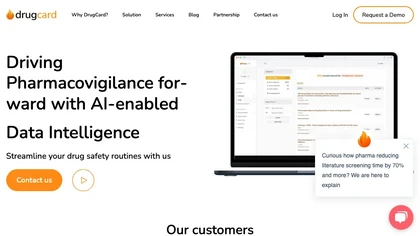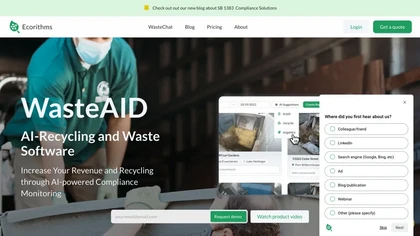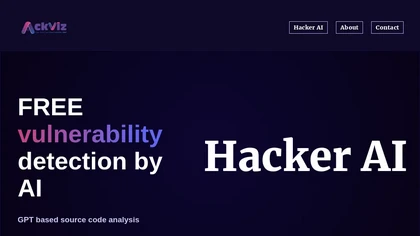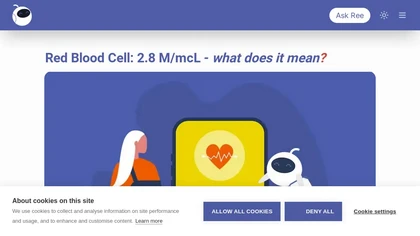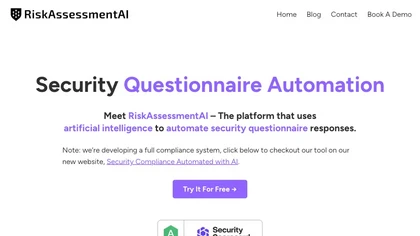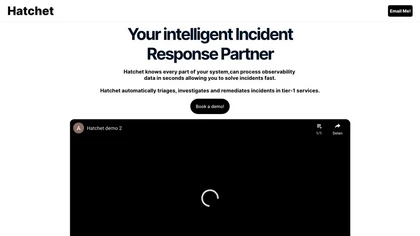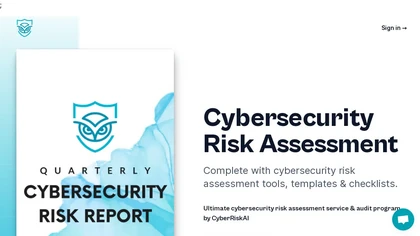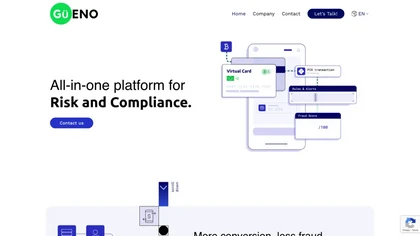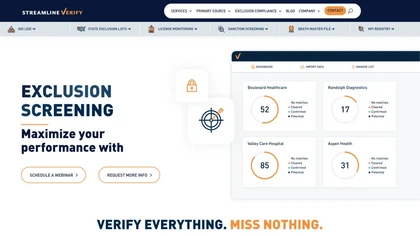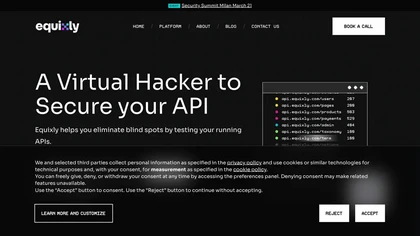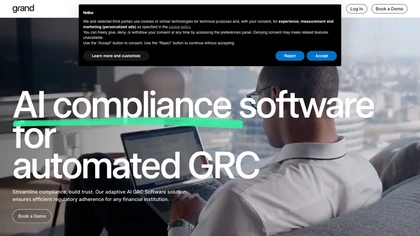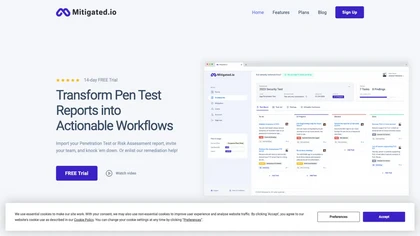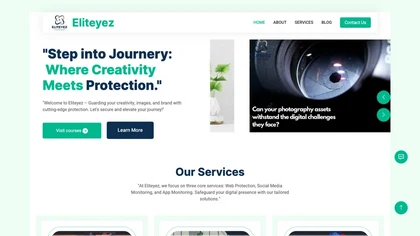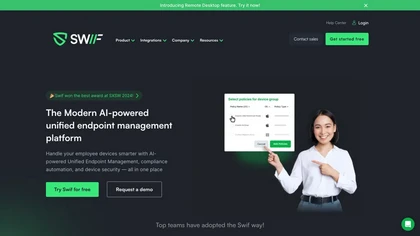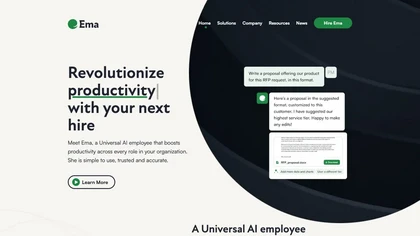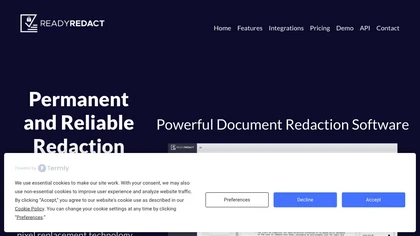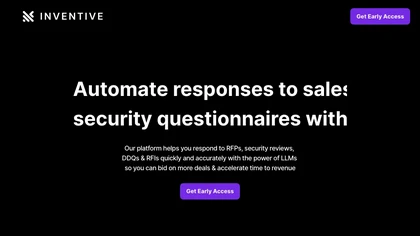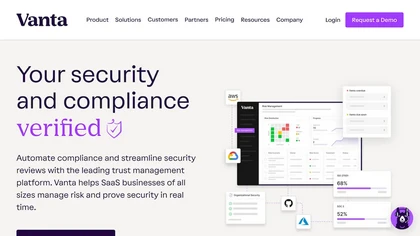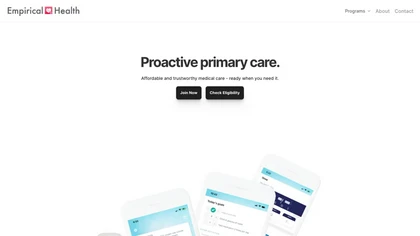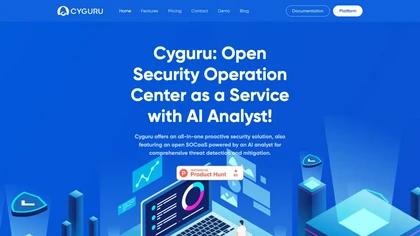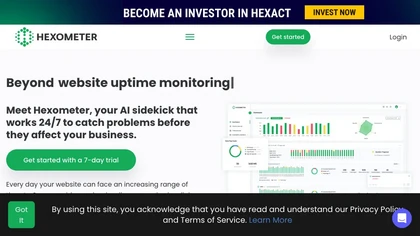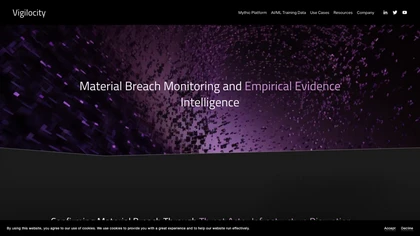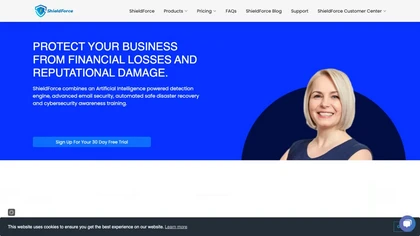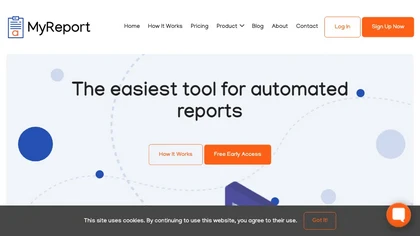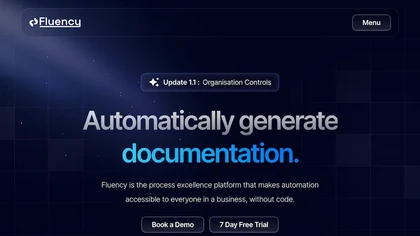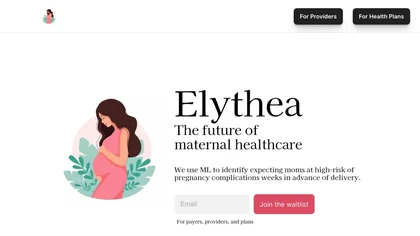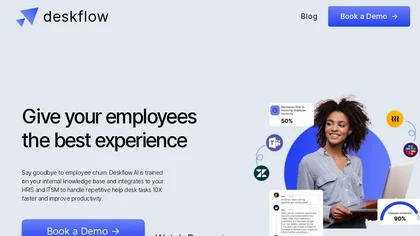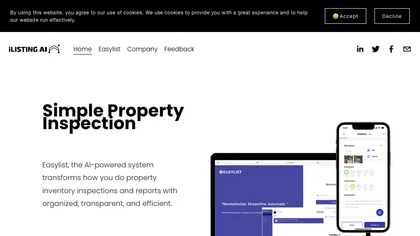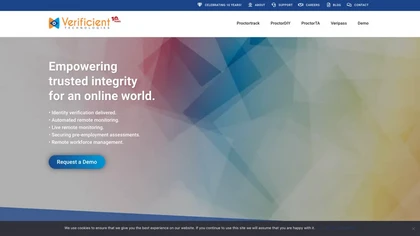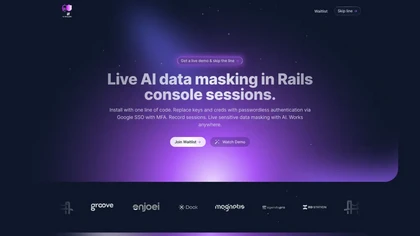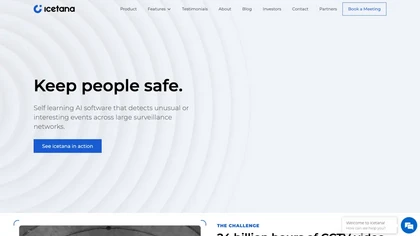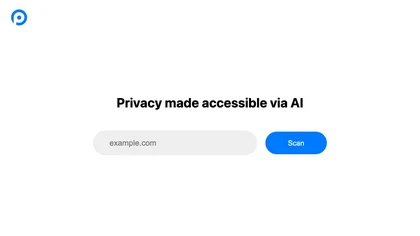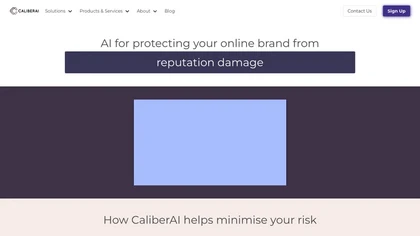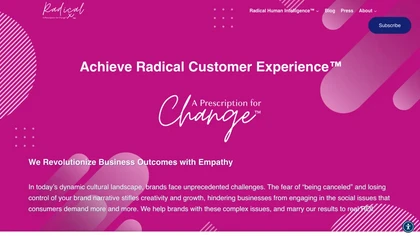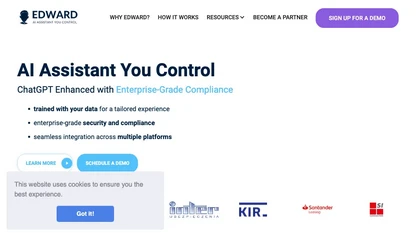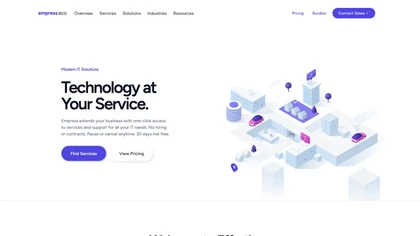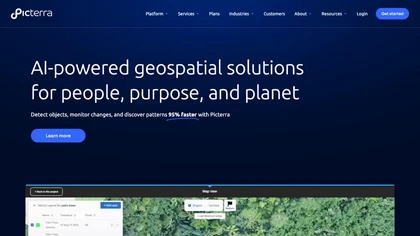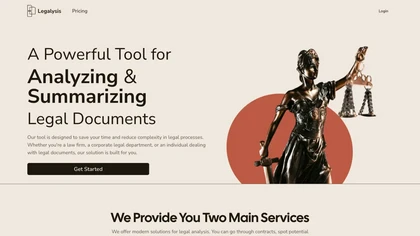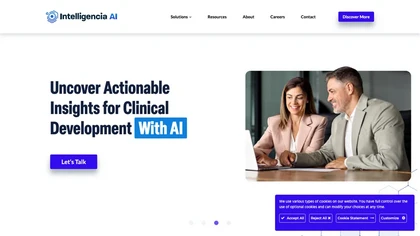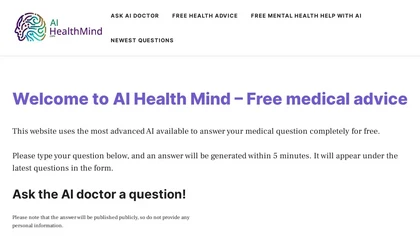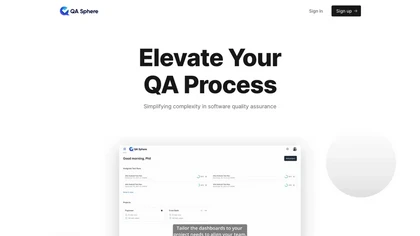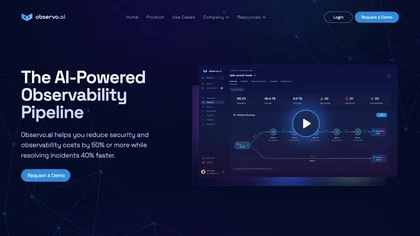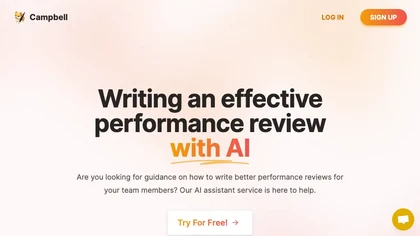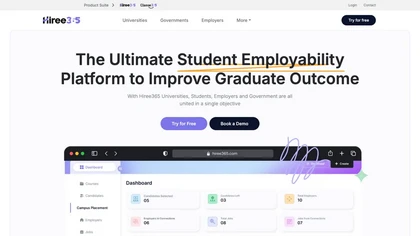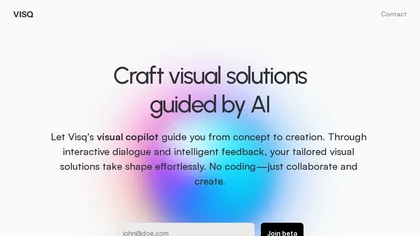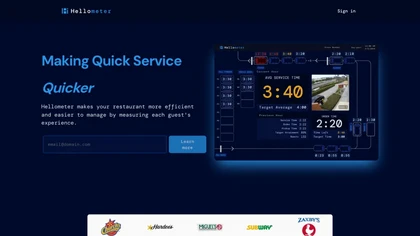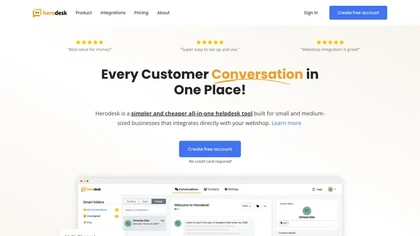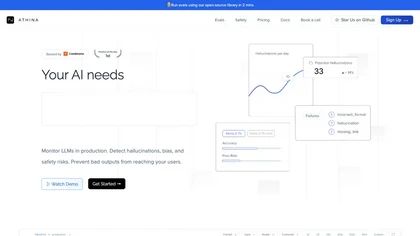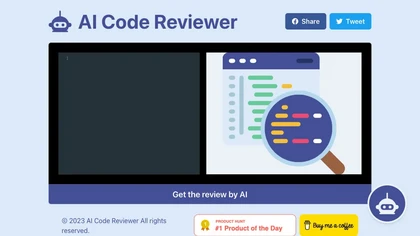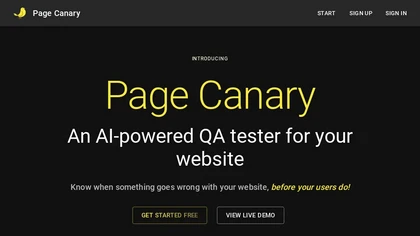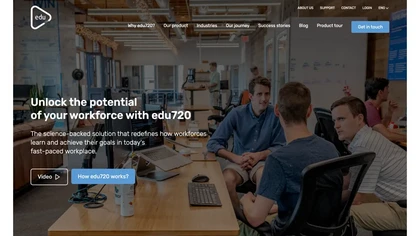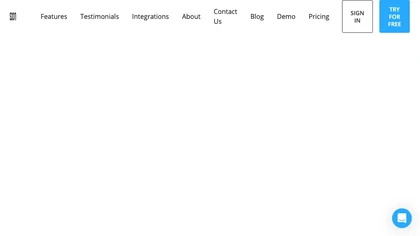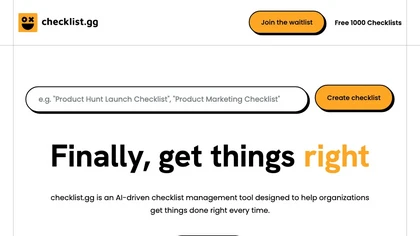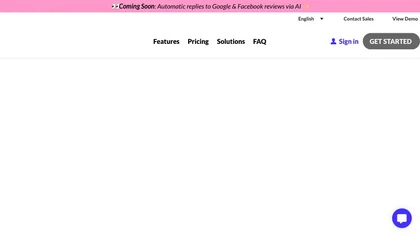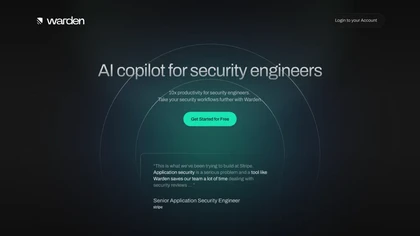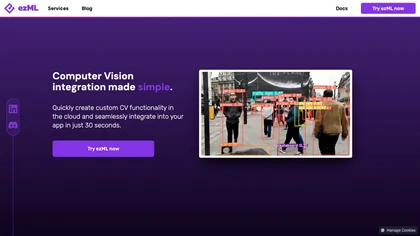AI use cases for Environmental Health and Safety
Generative AI can be applied in various applications for environmental health and safety. Here are some examples to explore below for inspiration with AI tools to get you started with using AI in environmental health and safety.
🛠️ 70 AI tools for Environmental Health and Safety
Explore a dynamic list of some of the most popular tools to get you started with various AI use cases and applications for Environmental Health and Safety to streamline your workflows and productivity today.
SWMS AI features
- Tailored risk assessments generation
- Customizable safety policies
- Personalized document generation
- Integration of AI assistant for safety information
- Streamlining compliance processes
SWMS features
- AI risk assessments
- Safety Co-Pilot integration
- Customization options
- Quickly generate safe work sequences
- AI-powered safety recommendations
Fluxguard features
- Web Change Monitoring using generative AI
- Screenshots and pixel change detection
- Text change detection and network analysis
- Real-time or scheduled report dispatch
- Email reports with screenshots and text changes
Inc. features
- Real-time global threat assessment
- Continuous monitoring and analysis of vast data sources
- Actionable intelligence delivery
- Comprehensive insights into evolving threats
- Integration of advanced data analytics, machine learning, and predictive modeling
Harvy features
- Automated work diary data entry
- Breach detection
- AI-driven automation for reducing human error risks
- Fast notice-to-produce reporting
- Online access to work diary sheets for up to 3 years
Gamma.ai
4.8Gamma.ai features
- Continuously monitors employees
- Notifies of security mistakes
DrugCard features
- Automates drug safety routines
- Multiple languages and countries
- High-performance screening
🔥
Create your account, save tools & get personal recommendations
Receive a weekly digest of our handpicked top tools.
Unsubscribe anytime
WasteAID features
- Automatic route auditing
- Integration with existing systems
- Audit over 400k generators and 1m+ pickups
- Detect overflow incidents and identify contamination
- Tracking commercial account compliance
Hacker AI
4.6Hacker AI features
- Source code scanning
- Security weakness identification
- Potential exploitation detection
- Hacker targeting prediction
- Malicious actor analysis
Ree AI features
- Explain medical reports
- Recommend supplements
- Check drug interactions
RiskAssessmentAI features
- Automate security questionnaire responses
- Scan documentation
- Build knowledge base
- Support various assessment formats
- Collaboration between teams
Hatchet features
- Automatically triages, investigates, and remediates incidents for tier-1 services
- Offers self-hosted deployments with robust security features like permissions, audit trails, SSO, and version control
- Ingests logs, codebases, and knowledge hubs to enable faster incident resolutions
- Proactively reads logs, communication channels, and code to suggest fixes for efficient incident triage and investigation
- Optimizes workflows by automating incident handling tasks to help engineers resolve critical incidents swiftly
PrivacyQuest features
- Record processing activities management
- Incident/breach management
- Individual rights management
- Consent management
- Automated document generation
Hexowatch features
- Detects visual changes
- Monitors content changes
- Alerts users about keyword changes
- Monitors technology stack changes
- Offers customizable monitoring options
Cyberriskai features
- Cybersecurity risk assessment
- Automated quarterly risk audits
- Nist cybersecurity audit framework
- Comprehensive assessment report
- Employee cybersecurity practices
Phishr features
- Interactive training
- Shows users what they missed in the email
- Preview of user experience when getting caught out
- Lifetime access for $1,400
- Training to identify phishing emails
AI-FraudGuard Ecommerce features
- Contactless conversion
- Fraud prevention
- Transaction monitoring
- Compliance processes automation
- Real-time monitoring
Streamline Verify features
- Screening against various databases including OIG LEIE, state exclusion lists, license monitoring, sanction screening, death master file, and NPI registry
- One-stop portal for quick identification and resolution of compliance screening issues
- API integration for future compliance needs
- Enhances efficiency in executing exclusion screening and credential management
- Trusted by over 10,000 establishments
Equixly features
- Continuous scanning of APIs for security vulnerabilities
- Detection and fixing of security issues in development process
- Scalable API pentesting capabilities
- Mapping of attack surface and inventory of API landscapes
- Transparent compliance reporting model
E-label.io features
- Generate e-labels with dynamic QR codes
- Upload nutritional information, ingredients, and lab results
- Customize stored data and attach QR code to wine labels
- Automatic translation support for EU languages
- Integration with ERP systems and web stores
hCaptcha features
- Comprehensive security platform
- Instant detection and deterrence of human and automated threats
- Easy deployment with universal support
- Advanced security measures against various threats
- Privacy and compliance features to meet global standards
Grand features
- Automated GRC software
- Efficient regulatory adherence
- Compliance workflows automation
- Policy and regulatory news monitoring
- Insights into regulatory changes
Mitigated.io features
- Transforms penetration test risk assessment reports into actionable workflows
- Leverages collaborative workspaces for task assignment and progress tracking
- Provides AI-enriched mitigation guidance for security vulnerabilities
- Supports easy import of assessment reports
- Enables users to enlist security mitigation services directly from the dashboard
Eliteyez features
- Web protection
- Social media monitoring
- App monitoring
- Focus on protecting intellectual property and creative assets
- Expert insights and practical tips on safeguarding creative assets on blog
Swif features
- Unified device management compliance automation
- Remote desktop feature
- Automated device security, access, and compliance management
- Support for MacOS, Windows, and Linux platforms
- Integration with Vanta, Drata, and Secureframe for SOC2 certification processes
Ema features
- Generative AI integration
- Emafusion™ model
- Data governance and security focus
- Integration with hundreds of enterprise apps
- Workflow automation across multiple applications
ReadyRedact Document Redaction features
- Redacting
- Documents
- Privacy
- Data protection
- Compliance
- Gdpr
- Ccpa
- Lgpd
- Popi
- Hipaa
Inventive features
- Streamline rfis, rfqs, security reviews, rfps
- Generate reliable answers with ai
- Reduce reliance on subject matter experts
- Save substantial time and effort
- Up-to-date content
Vanta features
- Automating security compliance processes
- Integration with over 300 security tools
- AI capabilities for accelerating security workflows
- Vendor risk management assistance
- Compliance with over 25 frameworks
Empirical Health features
- Proactive primary care
- Integration of consumer wearables for health monitoring
- Consultation with doctors via mobile app
- Personalized care plans
- Compatibility with major insurance providers
Cyguru features
- Cloud-based AI security operation center (SOC)
- AI-powered attack detection
- Continuous monitoring for vulnerabilities and misconfigurations
- Compliance with essential security standards (GDPR, PCI DSS, NIST)
- ML and AI detection capabilities for identifying anomalies and suspicious activities
Greenifs.ai features
- Detect greenwashing errors
- Ensure compliance with green marketing guidelines
- Check social media content for compliance with region-specific regulations
- Offer targeted corrections and recommendations
- Help avoid legal issues related to environmental laws
Hexometer features
- Website monitoring
- Issue detection
- Real-time notifications
- Agency dashboard
- White-label seo audits
- Performance tracking
Vigilocity features
- Utilizes bespoke training data
- Tracks, monitors, and disrupts threat actors
- Provides near instant notification of fraudulent domain registrations
- Prioritizes confirmed security breaches based on material impact
- Empowers security, audit, and regulatory teams with valuable insights
ShieldForce features
- Advanced email security system
- Automated disaster recovery capabilities
- Cybersecurity awareness training
- AI-based antimalware, antivirus, endpoint protection
- Data storage in Acronis datacenter and third-party cloud providers
MyReport features
- Automate data collection
- Automate citation
- Description of report topic
- Review of report
- Send report
Fluency.com features
- Automated Process Documentation
- Process Insights
- AI Assistant
- Automations
- Audit View
Elythea features
- Integration with ehr systems
- Personalized insights
- Early intervention
Deskflow features
- 10x faster handling of repetitive help desk tasks
- 90% reduction in employee communication time
- 50% reduction in time required to address employee issues
- Decrease in time spent by employees accessing crucial information
- Automation of ticket creation and assignment
Easylist features
- Automates property reporting
- Verifies inventory
- Documents claims
- Elevates processes
- Produces clear and cloud-based reports
Verificient features
- AI-powered tools for online identity verification and monitoring
- Proctortrack for secure remote proctoring
- Biometrics, computer vision, and machine learning capabilities
- Continuous identity verification and remote monitoring
- Live proctoring with AI and automated remote proctoring
PESTEL features
- Instant PESTEL analysis generation
- Detailed analysis covering Political, Economic, Social, Technological, Environmental, and Legal factors
- Utilizes descriptions provided to generate analysis
- Helps organizations understand and evaluate external macro-environmental factors
- Facilitates adaptation and success in the marketplace
Rails Guard features
- Live data masking for Rails console sessions
- Shielding Rails console access
- Passwordless authentication via Google SSO and MFA
- Automates employee onboarding and off-boarding
- Real-time sensitive data masking
Icetana features
- Real-time event detection
- Trip & fall detection
- Fire detection
- People & vehicle counting
- Self-learning AI technology
Privacy Observer features
- Automatically scans privacy policies
- Comprehensive score
- Detailed information on data handling
- Unlimited scans
- Anonymous checks
CaliberAI features
- Online article evaluator
- Real-time browser extension
- CMS integration
- Content scanning and risk detection
- AI technology with customizable API thresholds
Radical Human Intelligence™ features
- 3 R methodology support
- Deep stakeholder understanding
- Human level connections
- Informed decision making
- Fostering trust and collaboration
Edward features
- Seamless integrations
- Data analysis from various business systems
- Tailored experiences
- Security and compliance
- Expand functions
empress.eco features
- AI-powered automation
- On-demand outsourcing solutions
- Software integrations
- Helpdesk services
- Industry-specific solutions
Picterra features
- Object detection
- Change monitoring
- Pattern discovery
- Model training for mapping boundaries
- Efficient data analysis
Legalysis features
- Contract risk analysis
- Document summarization
- Legal Language Model (LLM)
- Cross-country risk pointing
- Time-saving document summarization
intelligencia.ai features
- Measuring the likelihood of success in drug development
- Identifying underlying drivers contributing to technical and regulatory risks
- Optimizing clinical trial design
- Standardizing risk evaluation processes
- Transparent and explainable AI features
AI Health Mind features
- Generate medical advice
- Answer medical questions
- Powered by cutting-edge technology
- Use of reliable medical databases
- Easy to use
QA Sphere features
- Digital checklist for managing tests
- Building a library of test cases
- Planning tests efficiently
- Organized test case library
- Integration with issue trackers
Observo features
- Intelligent AI-powered pipelines
- Automated observability pipelines
- Data optimization and reduction
- Anomaly detection
- Integration with 50+ sources and destinations
Campbell
5Campbell features
- Performance evaluation
- Goal setting
- Employee development
- Feedback collection
- Report generation
Hiree365 features
- Comprehensive platform for students, universities, employers, and governments
- 360° approach to graduate employment
- AI-powered tool for universities to manage recruitments
- AI-powered job screening and candidate assessment technology for employers
- Facilitates seamless connections between employers and universities
Hellometer features
- Drive-thru timer with camera-based insights
- Dining room timer for service speed tracking
- Surveillance capabilities with HD video
- Loss prevention features
- Global availability for security enhancements
Herodesk features
- Shared Inbox for better team collaboration
- Smart Folders for rule-based grouping of conversations
- Connect with multiple communication channels
- Integrates with popular e-commerce solutions
- Features include Quick Replies, Side conversations, Auto Responders, Signatures, Tags, Attachments, and more
Athina AI features
- Run evaluations using open-source library
- Detect hallucinations, bias, and safety risks
- Wide range of evaluation metrics
- Monitor, debug, analyze, and improve LLMS pipelines
- Complete privacy control and support for multiple user teams
AI Code Reviewer features
- Automatically analyzing code for syntax errors and security vulnerabilities
- Suggesting improvements and best practices for code quality
- Identifying potential bugs and areas for optimization
- Generating automated test cases to ensure correctness of the code
- Tracking code changes and providing historical reports on code quality
Page Canary features
- Ssl certificate expiry alerts
- Custom web page audits
- Monitoring website functionality
- Accessibility checks
- Compliance with security best practices
edu720 features
- AI-powered content
- Powerful analytics
- Nanolearning capabilities
- Mobile learning capabilities
- Support for various industries
Soon Pulse features
- Pre-built pulses
- Natural language processing technology
- Kpi monitoring
- Trend analysis
- Mental health check-ins
checklist.gg features
- Checklist management
- Task management
- Workflow management
- Real-time collaboration
- Integration with existing tools
HiFive features
- Review management
- Online reputation
- Attract new customers
- Capturing negative feedback
- Monitoring and replying to reviews
Warden features
- Streamlining security workflows
- Automated generation of technical architecture diagrams
- Identification of issues and risks within projects
- Automatic generation of risk factors
- Suggestion of possible mitigations for risks
White Hat features
- Personalized recommendations
- Real-time responses to queries
- Tailored guidance for offensive and defensive tactics
- Data-driven insights and continuous learning
- Expert guidance in cybersecurity strategies
ezML features
- Zero-shot learning
- Text-to-model capabilities
- Prebuilt vision pipelines
- Effortless deployment and integration
- Rapid inference support
